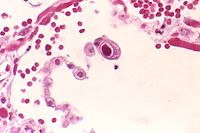
Photo from wikipedia
Abstract Background Resistant or refractory CMV infections are not well defined and may be associated with high morbidity and mortality in allogeneic hematopoietic cell transplant (allo-HCT) recipients. Suspicion of resistant… Click to show full abstract
Abstract Background Resistant or refractory CMV infections are not well defined and may be associated with high morbidity and mortality in allogeneic hematopoietic cell transplant (allo-HCT) recipients. Suspicion of resistant CMV infections is usually based on suboptimal responses to antiviral agents. Methods We performed a single-center retrospective chart review (January 2010 to September 2017) of Allo-HCT recipients who had CMV genotypic testing performed for suspected antiviral resistance. Based on the results, we categorized patients as either having refractory CMV (defined as CMV viremia that fails to decrease after at least 2 weeks of appropriately dosed and delivered antiviral therapy; and in the absence of known genetic mutations to the available antiviral agents) or resistant CMV infection (defined as refractory infection with identification of genetic mutations in the UL97 and/or UL54 genes correlating with in vitro antiviral resistance). Primary outcome was all-cause mortality. Results CMV genotypic resistance analysis was performed in 97 patients. Of those, 23 had resistant (11 had UL54 gene, 10 had UL97 gene, and two had both UL54 and 97) and 74 had refractory CMV infections. The majority of patients had AML (53%), underwent matched unrelated donor transplantation (43%), and received ATG during conditioning (64%). Patients with resistant CMV infections had a greater number of prior episodes when compared with those with refractory infections and had a longer time from transplant to suspicion of resistance (P < 0.01; each). Overall, the incidence of CMV disease was 41% (25% vs. 58% affecting the lungs and 56% vs. 17% the GI tract, in resistant vs. refractory infections, respectively). All-cause mortality was 57% (61% resistant vs. 55% refractory) and CMV-attributable mortality was 11% (9% resistant vs. 12% refractory). Conclusion Our data showed that resistant CMV infections are associated with a higher rate of CMV disease. However, both resistant and refractory CMV infections had increased all-cause mortality and similar CMV-attributable mortality. There was no difference in outcomes between allo-HCT recipients who had resistant or refractory CMV infections. New treatment strategies for resistant or refractory CMV infections are needed. Disclosures S. L. Aitken, Merck: Speaker’s Bureau, Consulting fee. E. Ariza-Heredia, Oxford Immunotec: Grant Investigator, Research grant. R. Chemaly, Merck: Consultant, Research grant; Chimerix: Consultant, Research grant; Novartis: Investigator, Research grant; Oxford Immunotec: Consultant, Research grant.
Journal Title: Open Forum Infectious Diseases
Year Published: 2018
Link to full text (if available)
Share on Social Media: Sign Up to like & get
recommendations!